Brief Postal History of India
Postage stamps and brief postal history of India
The history of India's postal system began long before the introduction of postage stamps. The communication of important military and political information was instituted by Cyrus the Great and Darius the First during the Persian Empire. For many centuries, messages were carried by a relay of runners on foot, but this was dangerous due to attacks by bandits and wild animals.
The first Sultan of Delhi, Qutb-ud-din Aybak (ruled from 1206 to 1210) created a messenger post system that was expanded into a ‘horse and foot runner’ service by Alauddin Khilji in 1296.
The runners were gradually replaced by horsemen under the rule of Sher Shah Suri (1541 to 1454).
In 1793, under the ‘Regulation of Permanent Settlement’ introduced by Cornwallis, private mail systems used hired runners for the commercial conveyance of messages, in direct competition to the East India Company’s mailing system. The runners were paid according to the travelled distance and the weight of their letters.
The Post Office Act XVII of 1837 provided that the Governor-General of India in Council had the exclusive right of conveying letters by post for hire within the territories of the East India Company, and the Indian Post Office was established on 1 October 1837.
The Scinde District Dawk
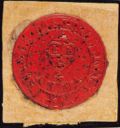
1852 red sealing wafer Scinde Dawk
Prepayment postage began in July 1852 in the Scinde / Sindh district with the use of the Dawk adhesive stamps. Embossed individually onto paper or a wax wafer, the shape was circular with ‘SCINDE DISTRICT DAWK’ around the rim and a central emblem of the British East India Company’s merchant’s mark. These scarce stamps were used until October 1854 and then suppressed
officially.
The Reforms of 1854 and the First Issues
The Commission of Inquiry studied the postal systems of Europe and America, and advocated one to be maintained for the benefit of the people of India and not for revenue purposes. The earlier practice of conveying official letters free of postage ("franking") was abolished and the new system was recommended by Governor-General Lord Dalhousie and adopted by the East India Company. Low and uniform rates were introduced with the basic rate of ½ anna.
De La Rue Design for the Recess Printed Issues
The East India Company attempted the ½ anna vermilion stamp in April but the pigment (available from England) was expensive and the substituted Indian destroyed the printing stones.
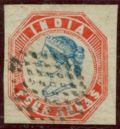
4 annas, 1854
The first stamps postal use throughout India were released in October 1854 with no perforations or gum, and featured a young frofile of Queen Victoria. The 4 annas value (illustrated above) was one of the world's first bicolored stamps.
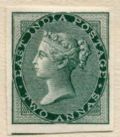
2 annas (East India Company), 1858
A new set of stamps printed by De La Rue were made available, with Queen Victoria in an oval vignette inside a rectangular frame with the inscription of ‘EAST INDIA POSTAGE’. These were used well after the British control of India’s administration in 1858. From 1865, the Indian stamps used paper watermarked with an elephant’s head.
The Reforms of 1866 and the Provisionals
By 1866, the volume of mail was doubled and by 1871, doubling again. Hence, the Postal Act reforms corrected some postal deficiencies and priviledges assigned to the East India Company were removed. In 1863, new rates were set for steamer mail operations to Europe at the rate of 6 annas 8 pies for a half-ounce letter. New designs for the ‘4 annas’ and ‘6 annas 8 pies’ stamps
were issued in 1866 but, the shortage of stamps forced ‘Foreign Bill revenue stamps’ to be cropped and overprinted ‘POSTAGE’. The occasional abuses of official franking were removed and official correspondence required careful control. These stamps were also used during the shortages and some rarities have been emerged during that period.
From 1874 to 1876, four new designs were issued and in 1882, a new set of stamps was issued for the proclamation of the Empire of India in 1877. These used the profile of Queen Victoria in a variety of frames and with the inscription of ‘INDIA POSTAGE’. The watermark changed to a star shape.
Postal history of Indian states
British India was an amalgamation of about 652 Princely States that most of them issued no postage stamps. Nevertheless, rarities have been discovered in this specific field of Indian philately and further study may be worthwhile.
The Convention States emerged as the ones with postal conventions (or agreements) with the Post Office of India, aiming to provide postal services within their territories. The adhesive stamps of British India were overprinted for use within each Convention State. Examples of such states were Patiala (1884), Chamba, Faridkot, Gwalior, Jind and Nabha . The Feudatory States maintained their own postal services within their territories and issued stamps with their
own designs. Many of these stamps were imperforate without gum, with many varieties of types, paper and inks. Letters mailed for non-local destination required additional British India postage.
Twentieth century
Edward VII
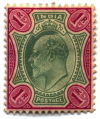
One rupee, (1902)
In 1895, the high value stamps of 2, 3 and 5 rupees were introduced and in 1900, stamps with existing designs were released in new colours. The 1902 King Edward the Seventh series reused design elements from the Victorian stamps with some colour changes and additional values up to 25 rupees. The higher values were used for telegraph and parcel fees
George V
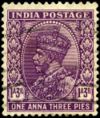
1 anna 3 pies, (1932)
The 1911 stamps of King George the Fifth had a different design. In 1919, the 1 ½ anna stamp was introduced with the inscription of ‘ONE AND HALF ANNA’ that was changed to ‘ONE AND A HALF ANNAS’ in 1921. The watermark changed to a pattern of multiple stars in 1926.
Inauguration of New Delhi
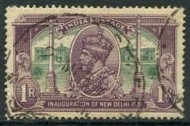 1 rupee (1931)
1 rupee (1931)
In 1931, we see the first appearance of pictorial stamps with a set of six stamps showing the fortress of Purana Qila and government edifices, in marking the government’s move from Calcutta to New Delhi. In 1935, another set shows buildings and commemorates King George’s Silver Jubilee.
The stamps issued in 1937 depict various forms of mail transports with King George the Sixth’s portrait appearing on the higher values. The new issue of 1941 used plain designs and limited usage of ink due to the austerity measures of World War II. A victory issue of 1946 was followed by the first Dominion issue, whose stamps depicted the Ashoka Pillar, the new flag of India and an airplane.
After Independence (1947)

Independent India's first stamp, issued on 21 November, 1947
As an independent country, the first stamp was issued on 21 November 1947 depicting the Indian Flag valued at 3 ½ annas.
Mahatma Gandhi (1948)
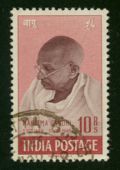
Satrunjaya, Jain Temple Complex, Palitana, (1949)
Issued on 15 August 1948 for the first anniversary of Independence, a ‘memorial’ stamp to Mahatma Gandhi was issued. In August 1949, a definitive series of postage stamps was released, with themes from India’s broad cultural heritage, such as Hindu, Muslem, Buddhist, Sikh and Jain temples, monuments, sculptures and fortresses. In 1955, a definitive issue reflected technological developments in the country and was denominated in naye paisa (decimal currency).
Today the Indian Postal Service has over 150,000 post offices that are widespread and provides financial services and small savings banking too.